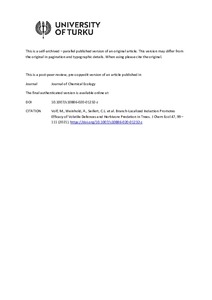Branch-Localized Induction Promotes Efficacy of Volatile Defences and Herbivore Predation in Trees
Salminen Juha-Pekka; Holicová Tereza; van Dam Nicole M.; Richter Ronny; Seifert Carlo L.; Weinhold Alexander; Uthe Henriette; Volf Martin; Wirth Christian; Alander Erika
https://urn.fi/URN:NBN:fi-fe2021042827388
Tiivistelmä
Induction of plant defences can show various levels of localization, which can optimize their efficiency. Locally induced responses may be particularly important in large plants, such as trees, that show high variability in traits and herbivory rates across their canopies. We studied the branch-localized induction of polyphenols, volatiles (VOCs), and changes in leaf protein content in Carpinus betulus L., Quercus robur L., and Tilia cordata L. in a common garden experiment. To induce the trees, we treated ten individuals per species on one branch with methyl jasmonate. Five other individuals per species served as controls. We measured the traits in the treated branches, in control branches on treated trees, and in control trees. Additionally, we ran predation assays and caterpillar food-choice trials to assess the effects of our treatment on other trophic levels. Induced VOCs included mainly mono- and sesquiterpenes. Their production was strongly localized to the treated branches in all three tree species studied. Treated trees showed more predation events than control trees. The polyphenol levels and total protein content showed a limited response to the treatment. Yet, winter moth caterpillars preferred leaves from control branches over leaves from treated branches within C. betulus individuals and leaves from control Q. robur individuals over leaves from treated Q. robur individuals. Our results suggest that there is a significant level of localization in induction of VOCs and probably also in unknown traits with direct effects on herbivores. Such localization allows trees to upregulate defences wherever and whenever they are needed.
Kokoelmat
- Rinnakkaistallenteet [27094]
